
mobile-encoding-android-v2_7
.pdf
Addendum B
Addendum
Table of Contents
1:Preface
2:Assumptions
2:Video and Audio Features in Flash for Mobile
3:Device Display Diversity
4:Network Connection Speed
5:Encoding Considerations
14:Video Encoding Considerations
17: Encoding Variants
23:Detailed AAC/AVC, Audio Video Settings
42: Conclusion
Mobile Encoding Guidelines for Android™ Powered Devices
Addendum to Video Encoding Cookbook and Profile Guidelines for the Adobe® Flash Platform
By Maxim Levkov, Adobe Systems Inc.
Preface
Mobile devices are quickly becoming a popular method of viewing media content. This rapid growth underscores the need for encoding guidelines to ensure that the content is optimized for reach and playback performance. It is not enough to simply deploy a single video player SWF with multi-bitrate content and expect a smooth playback experience on devices. For example, accommodations must be made for realities such as differing device capabilities, gesture interactions, screen orientation, and network connection speeds.
There are number of mobile platforms on the market today, but this document will focus specifically on Android™ powered devices. That being said, many of the general guidelines presented apply to other platforms as well. The continued evolution of Flash Player and the availability of increasingly powerful devices pushes video playback to the top of the list of most desired features on mobile networks today and well into the future.
This document is an addendum to the broader Video Encoding Cookbook and Profile Guidelines for the Adobe Flash Platform white paper. It would be beneficial to refer to that document, as well as the Best Practices for Mobile Device Video Player Optimization addendum also published separately.
Due to the wide variety of devices in the marketplace, there are two suggested approaches to encoding for mobile delivery. One approach is to target individual classes of mobile devices, optimizing encoding settings differently for each. The second approach is to service each of the diverse mobile phone devices through universally applicable encoding settings. Each of these approaches has advantages and disadvantages.
With the first approach, each of the device’s unique capabilities can be taken into consideration and specifically encoded for, thus optimizing the viewing experience and perceptual quality. This approach is advantageous when the player’s logic is set up to feed this specifically encoded content to that specific series of phone devices, or the aim is to service only an audience with a certain type of device, or even for local playback on device (e.g. download-to-own). The disadvantage of this approach is it’s limited reach, mainly due to differing technical capabilities of devices and optimization of encoded content to reach only a specific device. For example, a mobile device that is able to play back video encoded for H.264 Main Profile at Level 3.1 (e.g. high end class) will not play efficiently or even be recognized on a mobile device that is able to only support H.264 Baseline Profile at Level 3.1 (e.g. medium end class), or a device that is able to support only H.264 Baseline Profile at Level 2.1 (e.g. low end class).
Hence, in the second approach, which takes a more universal style towards encoding, content is encoded using the lowest common set of parameters. The advantage of this approach is of course it’s broad customer reach. The disadvantage is that is does not utilize each device’s unique capabilities and maximum playback quality. This translates to reduced picture frame size and perceptual quality for all viewers but the lowest-powered devices. For example, if the group of phone devices includes high end (e.g. H.264 Main Profile at Level 3.1 support), medium (e.g. H.264 Baseline Profile at Level 3.1 support), and low end (e.g. H.264 Baseline Profile at Level 2.1 support), then the content would be encoded using the low end H.264 Baseline Profile at Level 2.1, since it is supported by all of the targeted devices.

Some examples of these classes of devices* are outlined in Table 1.
Class |
Description |
High End |
Motorola Droid X/Droid 2, HTC Evo, HTC Droid Incredible |
|
|
Medium End |
Google Nexus One, Motorola BACKFLIP™ |
|
|
Low End |
Motorola Droid 1, Motorola CHARM™ |
*These devices are not exclusive representatives of their respective class of devices, and are presented for illustration purposes only.
Table 1
Sample Android powered devices and their classes.
Assumptions
Technical staff using this document should be skilled in the video coding technology field.
Quality control tools, viewing and listening conditions are tested and calibrated as described in Video Encoding Cookbook and Profile Guidelines for the Adobe Flash Platform, using the recommended test patterns and equipment.
Coded content is destined for appropriate compatible software and/or hardware decoders.
Coding software and hardware in use is functioning as stated.
Coding software and hardware supports at least some of the following coding elements mentioned throughout this document
Image Formats
Sizes |
128x96 to 1920x1088 |
Frame Rates |
23.976, 24, 25, 29.97, 30, 50, 59.94, 60fps or fraction thereof |
Aspect Ratio |
1.33, 1.78, 1.78 AN, 1.85, 2.35, including Letterbox and Pillarbox variants |
Color Space |
YUV 16 -235, Color Matrix 601 or 709 |
Video Sampling Structure |
4:2:0 |
H.264 Codec Parameter Set |
|
Coding Profiles |
Baseline, Main |
Coding Levels |
1 through 3.2 |
At least one of the following muxing |
F4V, MP4, MOV, 3GGP |
formats |
|
At least one of the following audio |
AAC LC, HEAAC v1, HEAAC v2 |
coding formats |
|
Video and Audio Features in Flash for Mobile
Flash Player provides acceleration features that aid in high-quality media playback on mobile devices.
Hardware Decoding of Audio
Hardware audio decoding uses the mobile device’s hardware to accelerate audio decoding. Without hardware decoding, audio decoding is an intensive process that involves complex parsing and decompression operations requiring high CPU cycles and power consumption.
Hardware decoding provides equivalent functionality to software decoding in Flash Player with accelerated AAC audio decoding (Main, LC, HE/SBR profiles), and provides the following features:
•High-quality audio playback experience.
•Overall reduction in CPU usage, freeing up CPU cycles for other operations, which in turn improves performance and battery life.
Mobile Encoding Guidelines for Android Powered Devices White Paper |
2 |
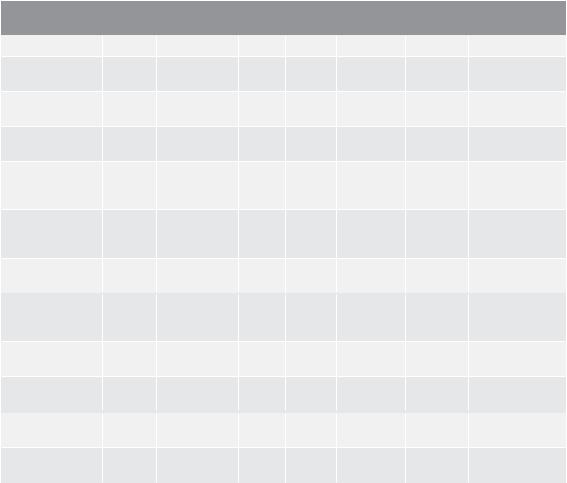
•Transparent to the user. If a hardware driver is not available or the audio codec format is not supported by the device hardware, Flash Player will fall back to software decoding.
Hardware Decoding of Video
Flash Player 10.1 introduced hardware-based H.264 video decoding to deliver smooth, high-quality video with minimal overhead across supported mobile devices and PCs.
Hardware accelerated rendering, GPU composition, and video hardware decoding combine to deliver high quality multimedia experiences on mobile devices with supported hardware. Benefits include:
•Offload tasks from the CPU to hardware, improving video playback performance, reducing system resource utilization, and preserving battery life.
•Deliver smooth, high-definition video with minimal overhead across devices.
•Use no CPU resources for video scaling. Audio and video can be decoded purely in hardware.
•Preserve battery life.
Device Display Diversity
Earlier, in the preface, device classification is mentioned as a means of identifying or grouping devices and the associated expectations for H.264 playback performance for these devices. It is useful to segment devices in this way not only for encoding purposes, but also for targeting display characteristics.
The following table highlights some examples of devices and their classes.
Phone Device |
Class |
Display |
Aspect |
Screen |
Pixel |
Frequency |
CPU |
|
Resolution |
Ratio |
Size |
Density |
|||||
|
|
|
|
|||||
|
|
Width x Height |
|
|
pixel/inch |
Mhz |
|
|
Motorola Droid X |
High |
854 x 480 |
1.78:1 |
4.3" |
228.3 |
1000 |
TI OMAP3630 |
|
|
End |
|
(16:9) |
|
|
|
|
|
Motorola Droid 2 |
High |
854 x 480 |
1.78:1 |
3.7" |
264.7 |
1000 |
TI OMAP3620 |
|
|
End |
|
(16:9) |
|
|
|
|
|
Motorola Droid Pro |
High |
480 x 320 |
1.5:1 |
3.1” |
185.5 |
1000 |
TI OMAP3620 |
|
|
End |
|
(15:10) |
|
|
|
|
|
HTC Evo |
High |
800 x 480 |
1.67:1 |
4.3" |
217.4 |
1000 |
Qualcomm |
|
|
End |
|
(15:9) |
|
|
|
Snapdragon |
|
|
|
|
|
|
|
|
QSD8650 |
|
HTC Droid |
High |
800 x 480 |
1.67:1 |
3.7" |
252.1 |
1000 |
Qualcomm |
|
Incredible |
End |
|
(15:9) |
|
|
|
Snapdragon |
|
|
|
|
|
|
|
|
QSD8650 |
|
Samsung Galaxy S |
High |
800x480 |
1.67:1 |
4.0” |
235.1 |
1000 |
Samsung-Intrisity |
|
|
End |
|
(15:9) |
|
|
|
S5PC110 |
|
|
|
|
|
|
|
|
|
|
Google Nexus One |
Medium |
800 x 480 |
1.67:1 |
3.7" |
252.1 |
998 |
Qualcomm |
|
|
End |
|
(15:9) |
|
|
|
Snapdragon |
|
|
|
|
|
|
|
|
QSD8250 |
|
HTC G2 |
Medium |
800 x 480 |
|
3.7 |
252.1 |
800 |
Qualcomm |
|
|
End |
|
|
|
|
|
MSM7230 |
|
Motorola Backflip |
Medium |
480 x 320 |
1.5:1 |
3.1" |
185.5 |
528 |
Qualcomm |
|
|
End |
|
(15:10) |
|
|
|
MSM7200A |
|
|
|
|
|
|
|
|
|
|
Motorola Droid 1 |
Low End |
800 x 480 |
1.67:1 |
3.7" |
266.7 |
600 |
TI OMAP3430 |
|
|
|
|
(15:9) |
|
|
|
|
|
Motorola Charm |
Low End |
320 x 240 |
1.33:1 |
2.6" |
143.1 |
600 |
TI OMAP3410 |
|
|
|
|
(4:3) |
|
|
|
|
|
Table 2 |
|
|
|
|
|
|
|
|
Examples of device classes. |
|
|
|
|
|
|
|
Mobile Encoding Guidelines for Android Powered Devices White Paper |
3 |
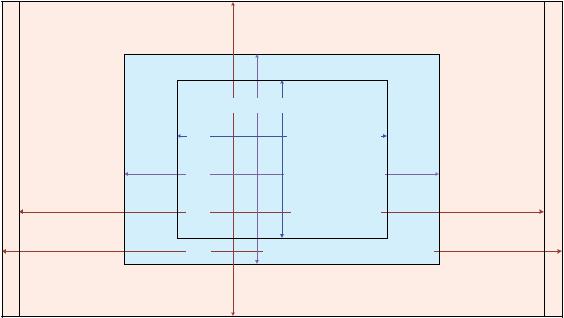
Although all of the devices in the previous table are able to display H.264 encoded video, and they even exhibit some display similarities across different classes, each device still has unique combination of specifications such as screen size and pixel density. These similarities and differences make encoding content for mobile delivery difficult. What is optimally encoded for High End class display and processing capabilities (e.g. HTC Evo, Motorola Droid X, etc. at 800x480, 854x480) may not display on all Medium End class devices (e.g. Motorola Backflip at 480x320), and also on Low End class display and processing capabilities devices (e.g. Motorola Charm at 320x240). For medium and low end class devices, the processor will be taxed when trying to display content encoded at higher resolutions. For devices with higher display resolution, down-scaling can cause processing issues and scaling up the lower resolution content results in a noticeably lower quality image.
Taking a closer look at the display resolutions of the classified devices provides clear guidelines for encoding content that plays well across devices.
Figure 1 depicts the device resolution, from Table 2, in 1 to 1 pixel relationship.
|
480 320 240 |
320 |
MOTOROLA CHARM |
480 |
MOTOROLA BACKFLIP |
800 |
GOOGLE NEXUS ONE |
HTC Evo |
|
|
HTC Droid Incredible |
854 |
MOTOROLA DROID/DROID2/DROID X |
Figure 1
Device resolution from Table 2, in 1:1 pixel relationship.
What makes the resolution of the display fit the size of the display is the areal density of pixels within given physical display size in pixel per inch ratio. Although this pixel density is not something that can be controlled by the user or encoder, the picture size and picture aspect ratio of the encoded video is in the control of the encoder.
Network Connection Speed
Another crucial element in high quality playback on mobile devices is the end user’s connection speed. For example, encoded content that is intended for delivery over broadband connections will not work efficiently over 3G networks due to their lower bandwidth capabilities. The end user connection that you decide to target will guide your encoding settings. Working within the boundaries of available network bandwidth for the targeted audience, while allowing for about 10-20% headroom for network fluctuations, is typically a good guideline to use as a starting point for optimal video playback. For example, if you determined through various means that the end users are only able to receive 500kbps of bandwidth, encoding for bandwidth of 800kbps will not yield a good playback experience. Although, 800kbps can still be delivered if using progressive delivery, but playback will stutter if the video data isn’t being received fast enough, or when the device’s buffer is full. So, while considering delivery to end user with 500kbps connection speed, encoding exactly at a bitrate of 500kbps will not provide a good experience either, as network conditions tend to be unpredictable. This is where the reduction of encoded data payload by 10-20% will play into effect. For 500kbps, it will be 400 – 450kbps effective total bitrate (i.e. audio and video combined).
Mobile Encoding Guidelines for Android Powered Devices White Paper |
4 |

The following table provides typical speed estimates of various networks, giving you a starting point for targeting bandwidth values.
EDGE |
Peak bit-rates of up to 1Mbit/s and typical bit-rates of 400kbit/s can be expected. |
3G |
Typical current average download speed is between 600 Kbit/s – 1.4 Mbit/s. |
|
|
4G |
Typical current average download speed is between 3 Mbit/s – 6 Mbit/s. |
|
|
HSPA+ |
Peak data rates up to 56 Mbit/s in the downlink in theory (up to 28 Mbit/s in existing services) |
|
and up to 22 Mbit/s in the uplink. |
WiFi |
Peak data rates up to 300 Mbit/s bi-directionally. |
Source: Wikipedia.org. For general reference only; actual rates may vary by network provider.
Table 3
Speed estimates of various networks.
Encoding Considerations
For more detailed explanation on how to prepare your content for highest quality playback, refer to Video Encoding Cookbook and Profile Guidelines for the Adobe Flash Platform, available for download at http://www.eventsadobe.com/cookbook.
The following ten guidelines should be followed when encoding content intended for mobile devices:
1.Keep the content in progressive output mode. Deinterlace whenever possible. Use Motion Compensated deinterlacing for best results. If not possible, use Motion Adaptive deinterlacing instead.
2.Use content that was deliberately shot for smaller screens for best user experience and fidelity. If not possible, scale with multi-tap filters (10 taps or more). The higher the tap the greater the sampling area (it is presumed that the filter is sophisticated enough to extract the necessary information to resample a better new image). High quality scaling filters utilize a higher sampling area from surrounding pixels (10 or more) and, thus, are able to derive higher quality output. Lower quality scaling filters (2-4 taps) create mediocre results, with images often being soft and blurry. Lower filter results may be acceptable for playback on the larger screen sizes of desktop computers, but will result in very poor picture quality on the smaller screen sizes of mobile devices. Lower end filters are faster than higher end filters due their smaller sampling area. Whenever possible and if available, use high quality scaling filters.
3.Maintain the aspect ratio of the original video.
4.Keep the frame size in multiples of 16 to avoid unnecessary performance degradation or CPU consumption. If not possible, resort only to multiples of 8, not 4.
5.If the transcoder/encoder supports two pass coding, use it. Typically a transcoder/encoder will use the first pass to index complex scenes and use the second pass for actual encoding. This process provides the best predictability for the coder and, consequentially, better output results. Depending on the complexity of the video, the perceptual video quality results from single pass to two pass encoding can vary as much as 10–30 percent, a valuable gain given the scarcity of bitrate resources.
6.Calibrate your Quality Assurance monitoring equipment for accurate representation of the output. (For more information on calibration and quality measurement, refer to the Video Encoding Cookbook and Profile Guidelines for the Adobe Flash Platform white paper.)
7.If the H.264 encoder supports “look_ahead” logic, use it. Specify at lames or greater, if coder permits.
8.Do not use content encoded at a larger frame size and then scale it down in the player. Create separate versions at the designated frame sizes at encoding or creation time. If higher frame size content is used, the device will attempt to scale it down, consuming excess CPU resources — as much as 40% in some cases.
This slows performance of the device, reduces battery life, and degrades the overall playback experience.
Mobile Encoding Guidelines for Android Powered Devices White Paper |
5 |
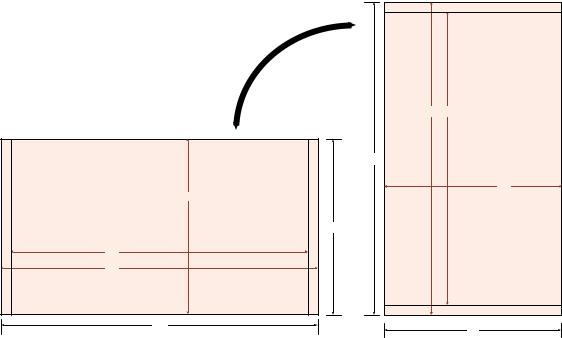
9.Do not use multiple slices mode in H.264. Instead, use 0 slices or 1 slice, or disable it all together. If slices are present in the video, the decoder will attempt to reproduce them while consuming unnecessary CPU resources.
10.If your source is interlaced and it needs to be scaled, deinterlace first then scale second.
Source
For best possible results, make sure that your source material is the highest quality available. It is strongly suggested that the original uncompressed source media file be used as an encoding source. Although this uncompressed media occupies considerably more disk space than a compressed (lossy) format, the encoding results are substantially better in quality than from a compressed source file — regardless of the level or method of compression. Because subsequent conversions will always exponentially decrease the sound and image quality, starting from a pristine and uncompromised video and audio file will ensure the best output for the final version.
Once you have a source to work with, properly formatting it for mobile delivery is as important as the quality of the source itself. This process involves resizing the original to a smaller frame size and compressing the video with mobile-friendly H.264 settings.
Picture Frame Sizes
Earlier, the section for Device Display Diversity detailed the impact frame sizes can have on performance of various classes of mobile devices. The highest display size for Android powered devices is 854x480 at 1.78:1 aspect ratio. The current highest display size on non-Android powered phone devices is 960x540 pixels (not including tablets).
When encoding for mobile devices it is important to minimize the impact on the processor by respecting the codec’s optimal macroblock division of 16x16 pixels, while maintaining source picture aspect ratio. Additionally, it is important to ensure that the picture falls within the maximum display size of the targeted device or group of devices.
Most mobile devices allow displaying content either in landscape (horizontal) viewing mode or in portrait (vertical) viewing mode.
854 |
800 |
16 |
|
|
480 |
480 |
|
9 |
|
800 |
|
854 |
|
16 |
9 |
|
|
HORIZONTAL |
VERTICAL |
Figure 2
Horizontal and vertical screen sizes. This display flexibility creates a technical challenge in rendering the experience in vertical and horizontal positioning modes.
Mobile Encoding Guidelines for Android Powered Devices White Paper |
6 |
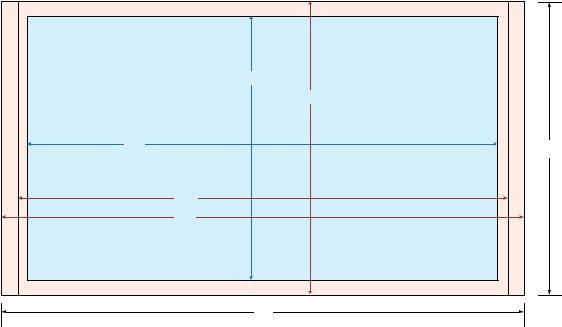
Horizontal (Landscape) Screen Positioning
If the maximum horizontal display sizes of your targeted devices are 854x480 and 800x480 there are two possible solutions for encoding optimal content with various picture aspect ratios.
|
432 |
|
480 |
768 |
9 |
|
|
|
800 |
|
854 |
|
16 |
Figure 3
Optimal 16:9 aspect ratio conversion for screen height of 480 pixels.
The frame size choice for this example, depicted in Figure 3, would be 768x432 because it is an exact 16x16 macroblock division and 1.777 (e.g. 16:9) aspect ratio. It also fits within the boundaries of the lowest resolution (800x480) of the two (854x480 and 800x480).
Solution one encodes the video with exact 16x16 macroblock division and exact matching aspect ratio (e.g. 16:9, 1.777:1) of the highest display size (e.g. 854x480) of the targets. The video is then scaled to fit the display, edge-to-edge, by the phone and player via full screen mode for the 854x480 size; and for the lower size of 800x480 the video is scaled to match the width of the player with the remaining height difference being filled with black bars on the top and bottom (letterbox).
Mobile Encoding Guidelines for Android Powered Devices White Paper |
7 |
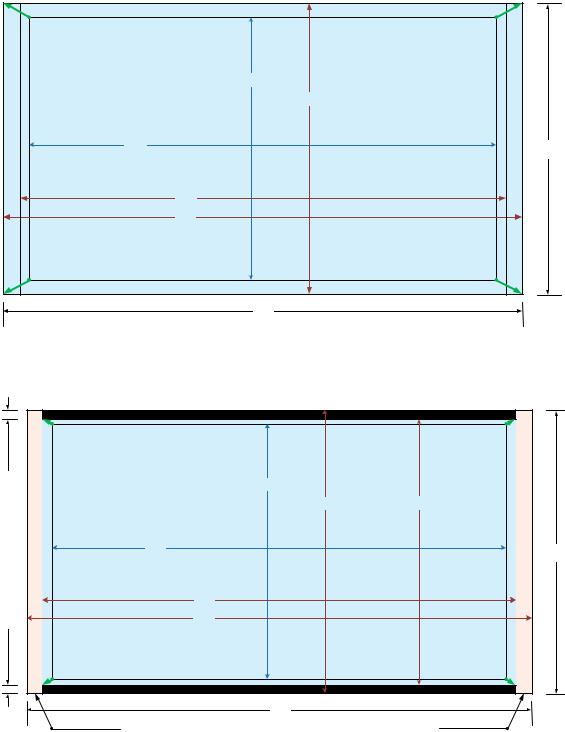
|
432 |
|
480 |
768 |
9 |
|
|
|
800 |
|
854 |
|
16 |
Figure 4
Scaling of 768x432 encoded picture size to fit 854x480 display size in “fit to screen mode,” while maintaining 16:9 original picture aspect ratio. The picture is scaled by 11.198% from original picture size.
BARS |
480 |
450 |
|
432 |
|
BLACK |
768 |
9 |
LETTERBOX |
|
|
800 |
|
|
|
|
|
|
854 |
|
|
16 |
|
|
OUTSIDE OF 800 X 480 RESOLUTION DISPLAY BOUNDARIES, FOR PRESENTATION ONLY |
|
Figure 5
Scaling of picture encoded at 768x432 sized to fit 800x480 display size. Actual fitted picture size is 800x450 at 16:9 original picture aspect ratio, the remaining area of 30 pixels (480-450) is filled with black bars, therefore forming a letterbox. The picture is scaled by 4.167% from the original picture size (black bars excluded).
Solution two, like solution one, encodes the video with exact 16x16 macroblock division and exact matching aspect ratio (e.g. 16:9, 1.777:1) of the highest display size (e.g. 854x480) of the targets. The video is then displayed in native source resolution with pillar and letterbox black bars filling the balance of the screen resolution for either 854x480 or 800x480 size.
Mobile Encoding Guidelines for Android Powered Devices White Paper |
8 |
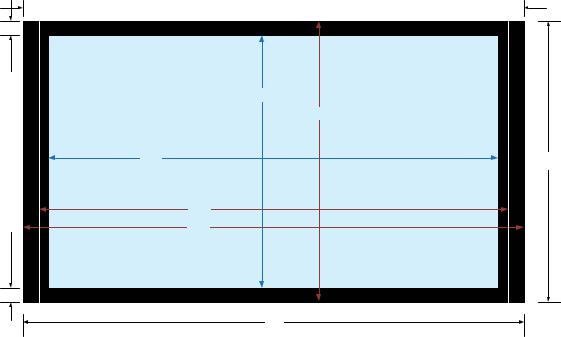
 PILLARBOX BLACK SIDE PANELS
PILLARBOX BLACK SIDE PANELS 

BARS |
|
432 |
|
|
|
||
BLACK |
|
480 |
|
768 |
9 |
||
LETTERBOX |
|||
|
854 |
||
|
|
800 |
|
|
|
16 |
Figure 6
Native resolution of picture encoded at 768x432 encapsulated by the pillarbox black side panels and letterbox black bars without any scaling.
The presentation effect of this type is referred to as a postage-stamp in extreme cases when the picture is reduced by nearly half of the screen and black bars occupy about three quarters of the screen, but not in the case depicted in Figure 5. Although, in this case it avoids scaling and retains minimal impact on the processing, usually it is not very appealing to the viewer. Try to resort to this type of presentation only in cases where you are concerned about the processing impact of scaling up. Notice that scaling up has less impact on the processing performance versus scaling down, due to the use of an additive scheme in scaling up mode and a deductive scheme in scaling down mode.
Vertical (Portrait) Screen Positioning
When the viewer positions the device in such a way that it triggers vertical rendering of the screen, the video is scaled and formatted to play back horizontally within the height and width boundaries of the screen. Since vertical positioning of the screen (as shown in Figure 2) significantly reduces available space for viewing the active video window, there are three possible approaches:
•Simply scale the existing video to fit the maximum width and height to fit within the boundaries of the device, but at the cost of even more reduced objects in the video.
•Request the pre-encoded video that fits within the boundaries of the screen
•Fit the video to the screen dimensions without applying scaling.
In most cases vertical positioning of the screen will create a perfect case for use of video with 4:3 picture aspect ratio and multi-bitrate delivery.
Scenario one uses horizontally rendered video for vertically triggered positioning on the screen with scaling down to vertical boundaries of the device, as depicted in the following pictogram. However, this approach reduces the objects on already small screen to even smaller picture with reducing the objects further, thus making them harder to see. Additionally, such scaling process pushes the performance on the device to suboptimal state because it requires the use of unnecessary CPU resource for scaling that video. Also, the same amount of bits is piped down the network pipeline unnecessarily. For example, the video encoded for horizontal display at 16:9 picture aspect ratio, and sized to fit within the boundaries of the devices’ screen resolution, such as 768x432 is encoded for 854x480 screen size, it will render at scaled 480 in width and corresponding height of 480x854 screen size in vertical position, or about 480x270 (at width x height) video resolution.
Mobile Encoding Guidelines for Android Powered Devices White Paper |
9 |
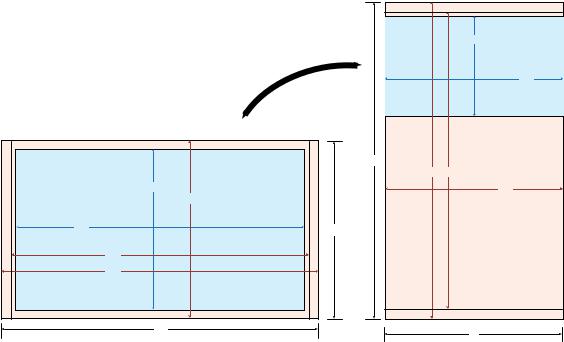
|
|
270 |
|
|
16:9 |
|
|
480 |
|
16 |
|
|
854 |
800 |
432 |
16:9 |
480 |
480 |
|
|
768 |
9 |
|
|
|
|
800 |
|
|
854 |
|
|
16 |
|
9 |
|
|
|
HORIZONTAL |
|
VERTICAL |
Figure 7
Fitting 16:9 aspect ratio video in vertical screen position from horizontal position.
Scenario two uses pre-encoded streams to fit the vertical positioned screen whenever the device is rotated to the vertical orientation. This approach is more complex than the first scenario, because it requires player logic to accommodate the different device position rendering whenever it is turned from horizontal to vertical state and vice versa. However, this scenario provides optimization on display of the video, reduced bit consumption due to reduced native video resolution requirements. This case also calls for use of 4:3 picture aspect ratio instead of 16:9, because it covers larger viewable area. For example, if video is encoded for horizontal display at 16:9 picture aspect ratio, and sized to fit within the boundaries of the devices’ screen resolution, such as 768x432 (16:9) is encoded for 854x432 screen size, it will render at 480x360 (4:3) from a separate stream at request of a player to fit the vertical position of 480x854 screen size.
Mobile Encoding Guidelines for Android Powered Devices White Paper 10
